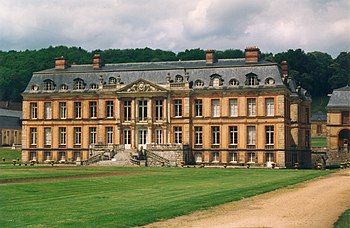
A mansard or mansard roof (also called French roof or curb roof) is a multi-sided gambrel-style hip roof characterised by two slopes on each of its sides, with the lower slope at a steeper angle than the upper, and often punctured by dormer windows.[1][2][3] The steep roofline and windows allow for additional floors of habitable space[4] (a garret), and reduce the overall height of the roof for a given number of habitable storeys. The upper slope of the roof may not be visible from street level when viewed from close proximity to the building.
The earliest known example of a mansard roof is credited to Pierre Lescot on part of the Louvre built around 1550. This roof design was popularised in the early 17th century by François Mansart (1598–1666),[5] an accomplished architect of the French Baroque period.[6] It became especially fashionable during the Second French Empire (1852–1870) of Napoléon III.[7] Mansard in Europe (France, Germany and elsewhere) also means the attic or garret space itself, not just the roof shape[8] and is often used in Europe to mean a gambrel roof.
- ^ AMHER, 4th edition, 2000: mansard.
- ^ "mansard". WordNet 3.0. Princeton University.
- ^ Architecture Glossary, City of Rockville, Maryland,
mansard – two slopes on each of its four sides; one part very steep and curved, often with dormers
- ^ "Building Terms". Michael Roberts & Associates.
Mansard: A roof made with slopes of different pitches, usually providing an upper floor of usable space within a roof structure.
- ^ What is a Mansard Loft?
- ^ Fleming, William. "Western architecture". Encyclopædia Britannica.
- ^ Alexander, Francis. "Glossary – House Style Definitions". House Proud. Archived from the original on 2009-10-24. Retrieved 2010-03-30.
Mansard: A hipped roof with two pitches; the lower is the steeper, while the pitch approaching the ridge is much gentler, sometimes almost flat. Associated with Second Empire architecture.
- ^ "Mansard". Oxford English Dictionary (2nd ed.). 1997.